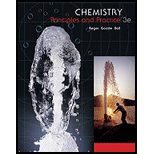
Concept explainers
(a)
Interpretation:
Enthalpy change for the given reaction should be calculated and has to be labelled as endothermic or exothermic. The given reaction is,
Concept introduction:
Enthalpy
The value of standard enthalpy change
Where,
n is the number of moles.
(a)
Answer to Problem 5.81QE
Enthalpy change is
Explanation of Solution
The balanced equation for the given reaction follows as,
Standard enthalpy of formation values is given below,
Change in enthalpy can be calculated by the equation:
Substitute the values as follows,
The sign of enthalpy change is positive. Hence, it is an endothermic reaction.
(b)
Interpretation:
Enthalpy change for the given reaction should be calculated and has to be labelled as endothermic or exothermic. The given reaction is,
Concept introduction:
Refer to (a).
(b)
Answer to Problem 5.81QE
Enthalpy change is
Explanation of Solution
The balanced equation for the given reaction follows as,
Standard enthalpy of formation values is given below,
Change in enthalpy can be calculated by the equation:
Substitute the values as follows,
The sign of enthalpy change is negative. Hence, it is an exothermic reaction.
(c)
Interpretation:
Enthalpy change for the given reaction should be calculated and has to be labelled as endothermic or exothermic. The given reaction is,
Concept introduction:
Refer to (a).
(c)
Answer to Problem 5.81QE
Enthalpy change is
Explanation of Solution
The balanced equation for the given reaction follows as,
Standard enthalpy of formation values is given below,
Change in enthalpy can be calculated by the equation:
Substitute the values as follows,
The sign of enthalpy change is negative. Hence, it is an exothermic reaction.
Want to see more full solutions like this?
Chapter 5 Solutions
Chemistry
- One step in the manufacturing of sulfuric acid is the conversion of SO2(g) to SO3(g). The thermochemical equation for this process is SO2(g)+12O2(g)SO3(g)H=98.9kJ The second step combines the SO3 with H2O to make H2SO4. (a) Calculate the enthalpy change that accompanies the reaction to make 1.00 kg SO3(g). (b) Is heat absorbed or released in this process?arrow_forwardUse Hesss law to calculate the enthalpy change for the formation of CS2() from C(s) and S(s) [C(s) + 2 S(s) CS2()] from the following enthalpy values. C(s)+O2(g)CO2(g)rH1=393.5kJ/mol-rxnS(s)+O2(g)SO2(g)rH2=296.8kJ/mol-rxnCS2(l)+3O2(g)CO2(g)+2SO2(g)rH3=1103.9kJ/mol-rxnarrow_forwardUsing the data in Appendix G, calculate the standard enthalpy change for each of the following reactions: (a) Si(s)+2F2(g)SiF4(g) (b) 2C(s)+2H2(g)+O2(g)CH3CO2H(l) (c) CH4(g)+N2(g)HCN(g)+NH3(g) ; (d) CS2(g)+3Cl2(g)CCl4(g)+S2Cl2(g)arrow_forward
- The thermochemical equation for the burning of methane, the main component of natural gas, is CH4(g)+2O2(g)CO2(g)+2H2O(l)H=890kJ (a) Is this reaction endothermic or exothermic? (b) What quantities of reactants and products are assumed if H = 890 kJ? (c) What is the enthalpy change when 1.00 g methane burns in an excess of oxygen?arrow_forwardA 0.470-g sample of magnesium reacts with 200 g dilute HCl in a coffee-cup calorimeter to form MgCl2(aq) and H2(g). The temperature increases by 10.9 C as the magnesium reacts. Assume that the mixture has the same specific heat as water and a mass of 200 g. (a) Calculate the enthalpy change for the reaction. Is the process exothermic or endothermic? (b) Write the chemical equation and evaluate H.arrow_forwardGive the definition of the standard enthalpy of formation for a substance. Write separate reactions for the formation of NaCl, H2O , C6H12O6, and PbSO4 that have H values equal to Hf for each compound.arrow_forward
- 9.73 Without looking up any numerical data or doing calculations, predict whether the enthalpy change for each of the following reactions should he positive, negative, or zero. (a) H2O(l)H2O(s) (b) N2(g)2N(g) (c) CH4(g)+2O2(g)CO2(g)+2H2O(l) (d) CO2(s)CO2(g)arrow_forwardIs the following reaction the appropriate one to use in determining the enthalpy of formation of methane, CH4(g)? Why or why not? C(g)+4H(g)CH4(g)arrow_forwardAssume 200. mL of 0.400 M HCl is mixed with 200. mL of 0.400 M NaOH in a coffee-cup calorimeter The temperature of the solutions before mixing was 25.10 C; after mixing and allowing the reaction to occur, the temperature is 27.78 C. What is the enthalpy change when one mole of acid is neutralized? (Assume that the densities of all solutions are 1.00 g/mL and their specific heat capacities are 4.20 J/g K.)arrow_forward
- When 2.50 g of methane burns in oxygen, 125 kJ of heat is produced. What is the enthalpy of combustion per mole of methane under these conditions?arrow_forwardThe enthalpy change for the following reaction is 393.5 kJ. C(s,graphite)+O2(g)CO2(g) (a) Is energy released from or absorbed by the system in this reaction? (b) What quantities of reactants and products are assumed? (c) Predict the enthalpy change observed when 3.00 g carbon burns in an excess of oxygen.arrow_forwardAnother reaction that is used to propel rockets is N2O4(l)+2N2H4(l)3N2(g)+4H2O(g) This reaction has the advantage that neither product is toxic, so no dangerous pollution is released. When the reaction consumes 10.0 g liquid N2O4, it releases 124 kJ of heat. (a) Is the sign of the enthalpy change positive or negative? (b) What is the value of H for the chemical equation if it is understood to be written in molar quantities?arrow_forward
 Chemistry: Principles and PracticeChemistryISBN:9780534420123Author:Daniel L. Reger, Scott R. Goode, David W. Ball, Edward MercerPublisher:Cengage LearningChemistry: Matter and ChangeChemistryISBN:9780078746376Author:Dinah Zike, Laurel Dingrando, Nicholas Hainen, Cheryl WistromPublisher:Glencoe/McGraw-Hill School Pub Co
Chemistry: Principles and PracticeChemistryISBN:9780534420123Author:Daniel L. Reger, Scott R. Goode, David W. Ball, Edward MercerPublisher:Cengage LearningChemistry: Matter and ChangeChemistryISBN:9780078746376Author:Dinah Zike, Laurel Dingrando, Nicholas Hainen, Cheryl WistromPublisher:Glencoe/McGraw-Hill School Pub Co Chemistry by OpenStax (2015-05-04)ChemistryISBN:9781938168390Author:Klaus Theopold, Richard H Langley, Paul Flowers, William R. Robinson, Mark BlaserPublisher:OpenStax
Chemistry by OpenStax (2015-05-04)ChemistryISBN:9781938168390Author:Klaus Theopold, Richard H Langley, Paul Flowers, William R. Robinson, Mark BlaserPublisher:OpenStax Chemistry for Engineering StudentsChemistryISBN:9781337398909Author:Lawrence S. Brown, Tom HolmePublisher:Cengage Learning
Chemistry for Engineering StudentsChemistryISBN:9781337398909Author:Lawrence S. Brown, Tom HolmePublisher:Cengage Learning Chemistry & Chemical ReactivityChemistryISBN:9781337399074Author:John C. Kotz, Paul M. Treichel, John Townsend, David TreichelPublisher:Cengage Learning
Chemistry & Chemical ReactivityChemistryISBN:9781337399074Author:John C. Kotz, Paul M. Treichel, John Townsend, David TreichelPublisher:Cengage Learning Chemistry: The Molecular ScienceChemistryISBN:9781285199047Author:John W. Moore, Conrad L. StanitskiPublisher:Cengage Learning
Chemistry: The Molecular ScienceChemistryISBN:9781285199047Author:John W. Moore, Conrad L. StanitskiPublisher:Cengage Learning





